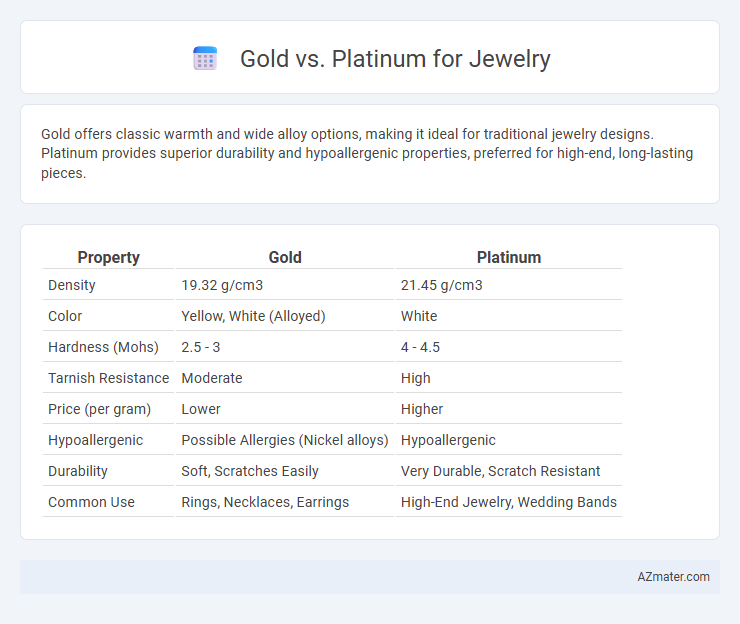Gold offers classic warmth and wide alloy options, making it ideal for traditional jewelry designs. Platinum provides superior durability and hypoallergenic properties, preferred for high-end, long-lasting pieces.
Table of Comparison
| Property | Gold | Platinum |
|---|---|---|
| Density | 19.32 g/cm3 | 21.45 g/cm3 |
| Color | Yellow, White (Alloyed) | White |
| Hardness (Mohs) | 2.5 - 3 | 4 - 4.5 |
| Tarnish Resistance | Moderate | High |
| Price (per gram) | Lower | Higher |
| Hypoallergenic | Possible Allergies (Nickel alloys) | Hypoallergenic |
| Durability | Soft, Scratches Easily | Very Durable, Scratch Resistant |
| Common Use | Rings, Necklaces, Earrings | High-End Jewelry, Wedding Bands |
Introduction to Gold and Platinum in Jewelry
Gold, a highly valued precious metal, has been a timeless favorite in jewelry due to its natural luster, malleability, and resistance to tarnish, often alloyed with metals like copper or silver to enhance durability and color variations. Platinum, rarer and denser than gold, stands out for its exceptional strength, hypoallergenic properties, and naturally white sheen that resists aging and wear, making it ideal for high-end and heirloom jewelry. Both metals serve as symbols of luxury and status, with gold preferred for its warm tones and widespread historical use, while platinum appeals to those seeking longevity and purity in fine jewelry.
Historical Significance of Gold and Platinum
Gold has been revered for thousands of years, symbolizing wealth, power, and divine connection in ancient civilizations such as Egypt and Mesopotamia. Platinum, rediscovered in the 18th century, gained prominence due to its rarity and durability, often associated with modern luxury and exclusivity. Both metals hold distinct historical significance, with gold embodying timeless tradition and platinum representing innovation in fine jewelry.
Physical Properties: Strength and Durability
Platinum exhibits superior strength and durability compared to gold, making it highly resistant to scratches and wear over time. Gold, especially in higher karats, is softer and more prone to bending and scratching, although its alloyed forms like 14K or 18K gold offer enhanced hardness. Platinum's dense molecular structure contributes to its long-lasting performance, ideal for jewelry that endures daily wear.
Color and Aesthetic Appeal
Gold offers a warm, rich yellow hue that complements various skin tones and timeless jewelry designs, making it a classic choice for elegance and tradition. Platinum features a naturally white, lustrous sheen that enhances the brilliance of gemstones and provides a modern, sophisticated aesthetic with exceptional durability. Both metals maintain their color over time, but platinum's resistance to tarnish ensures a consistently sleek and polished appearance.
Hypoallergenic Qualities and Skin Sensitivity
Platinum is highly favored for jewelry due to its natural hypoallergenic properties, making it an ideal choice for individuals with sensitive skin or metal allergies. Gold, especially when mixed with other metals in lower karat forms, may cause skin irritation, though 24k gold is less likely to trigger reactions but is softer. Choosing platinum over gold ensures durability and minimizes skin sensitivity, offering a premium option for hypoallergenic jewelry.
Maintenance and Care Requirements
Gold jewelry requires regular polishing to maintain its shine and is more prone to scratches, especially softer purity levels like 14K or 18K. Platinum, being denser and more durable, resists wear and tarnish better but develops a patina over time that some owners appreciate as a unique characteristic. Both metals need cleaning with appropriate solutions, but platinum demands less frequent maintenance, making it ideal for everyday wear.
Pricing and Market Value Comparison
Gold jewelry typically commands higher market value due to its widespread demand and historical significance as a store of wealth, with prices fluctuating around $60 per gram as of 2024. Platinum, although rarer and more durable, usually has a slightly lower market price, averaging about $30 to $40 per gram, but commands a premium in luxury jewelry segments for its hypoallergenic properties. Pricing for both metals is influenced by global bullion markets and craftsmanship, with gold often favored for investment while platinum is preferred for exclusive, high-end jewelry collections.
Popular Gold and Platinum Jewelry Types
Gold jewelry, particularly 14K and 18K varieties, remains a popular choice for engagement rings, wedding bands, and intricate necklaces due to its warm hue and malleability. Platinum, favored for its durability and naturally white sheen, is commonly selected for high-end engagement rings, wedding bands, and luxury earrings, offering hypoallergenic properties. Both metals cater to different style preferences and budget considerations, with gold providing versatility and platinum delivering long-lasting strength.
Resale Value and Investment Potential
Gold jewelry maintains a higher resale value due to its widespread demand and recognized market stability, often priced by weight and purity in karats. Platinum, though rarer and more durable, can fluctuate more in resale value because of varying industrial uses and less established secondary markets. Investors prioritize gold for liquidity and consistent appreciation, while platinum's investment potential lies in its industrial demand and limited supply, making it more volatile.
Choosing Between Gold and Platinum: Key Considerations
Choosing between gold and platinum for jewelry depends on factors such as durability, hypoallergenic properties, and price. Platinum offers superior strength and natural hypoallergenic qualities, making it ideal for sensitive skin and everyday wear, while gold provides a wider variety of colors and affordability. Consider alloy composition, maintenance needs, and personal style preferences to select the best metal for long-lasting, beautiful jewelry.

Infographic: Gold vs Platinum for Jewelry
 azmater.com
azmater.com